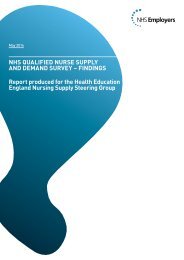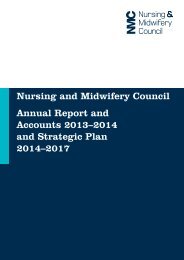Journal_1_2014_final_WEB
Journal_1_2014_final_WEB
Journal_1_2014_final_WEB
Create successful ePaper yourself
Turn your PDF publications into a flip-book with our unique Google optimized e-Paper software.
Scientific Communication<br />
Nutrition and chronic wounds<br />
Series (no. 12) of Technical Documents<br />
of the GNEAUPP (National Advisory<br />
Group for the Study of Pressure Ulcers<br />
and Chronic Wounds). Logroño, 2011.<br />
This technical document was based on a<br />
comprehensive and systematic review of<br />
the literature. It was submitted for consensus<br />
agreement by the National Advisory Group<br />
for the Study of Pressure Ulcers and Chronic<br />
Wounds (GNEAUPP). The result was a 68-page<br />
document that included 201 bibliographic references<br />
with two appendices of nutritional screening<br />
tools.<br />
The document is divided into four (4) sections:<br />
1. Introduction. This section defines the concept<br />
of wounds and wound variants as well as different<br />
treatment modalities, including the concepts of<br />
food, nutrition, and how they affect treatment.<br />
It also defines the broader concept of malnutrition,<br />
which is caused by unhealthy diets that may<br />
have an excess or deficit of food energy. Thus,<br />
malnutrition can occur in obese or underweight<br />
individuals, and in both cases, results in deficiencies<br />
of essential nutrients.<br />
2. Current state of knowledge. This section reviews<br />
current knowledge on nutrition, pressure<br />
ulcers, and wound prevention and treatment.<br />
The first subsection refers to epidemiology and<br />
existing reports published in the literature on nutritional<br />
status and chronic wounds. Specifically,<br />
it focuses on the epidemiology of malnutrition<br />
and wounds, and their relationship according to<br />
wound aetiology. A distinction is made between<br />
nutritional status and pressure ulcers (the type<br />
of wound most referenced in the literature and<br />
related to nutrition), and nutritional status and leg<br />
ulcers. Here, there are few references in the literature.<br />
This subsection concludes with an exploration<br />
of nutritional status and wound dehiscence.<br />
Scientific evidence, obtained primarily from observational<br />
studies, links malnutrition directly<br />
to pressure ulcer severity and incidence. Regarding<br />
diabetic foot ulcers, good glycaemic control<br />
is thought to be important in neuropathic ulcer<br />
healing; however, little evidence exists to support<br />
this idea. Regarding ulcers of venous aetiology,<br />
few studies have investigated the role of nutrition<br />
in healing. One study reported that people<br />
with this pathology have lower levels of vitamins<br />
A and E, carotenes, and zinc; however, to date, no<br />
evidence has been presented to confirm that supplementation<br />
with these micronutrients improves<br />
healing. Regarding wound dehiscence, it is known<br />
that this complication is 8 times more common<br />
in vitamin C-deficient patients than in patients<br />
with normal vitamin C levels. In addition, obese<br />
patients are thought to have more infections and<br />
delayed wound healing, as well as a greater incidence<br />
of dehiscence.<br />
The second subsection deals with the assessment,<br />
screening, and diagnosis of malnutrition, with special<br />
emphasis on nutritional screening and assessment<br />
tools. A description is provided of steps to<br />
follow in nutritional assessment, as recommended<br />
in the guidelines of leading societies dedicated to<br />
nutrition science. Regarding nutritional assessment<br />
and screening, recommendations are made<br />
about the collection of clinicometric data for the<br />
various instruments and tools, which are validated<br />
and based on research.<br />
Assessment consists of two parts: nutritional<br />
screening and the nutritional assessment itself. The<br />
purpose of screening is to identify malnourished<br />
individuals or those at nutritional risk. For these<br />
individuals, a complete assessment is required.<br />
The guidelines of the European Society for Clinical<br />
Nutrition and Metabolism (ESPEN) for nutritional<br />
screening recommend a series of steps that<br />
must be considered for all hospitalised patients:<br />
<br />
José Verdú Soriano<br />
PhD, MSc Nurse<br />
The University of<br />
Alicante, Spain<br />
Estrella Perdomo Pérez<br />
MSc Nurse<br />
Miller Bajo Health Center<br />
Las Palmas, Spain<br />
Correspondence:<br />
pepe.verdu@ua.es<br />
www.gneaupp.es<br />
Conflict of interest: none<br />
EWMA <strong>Journal</strong> <strong>2014</strong> vol 14 no 1 51




